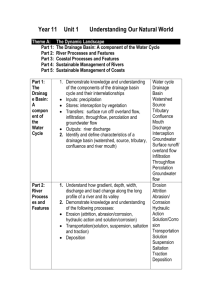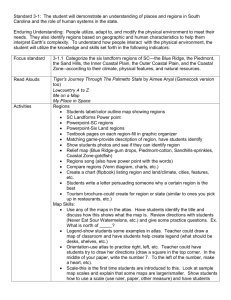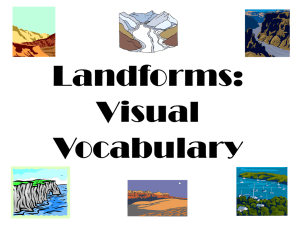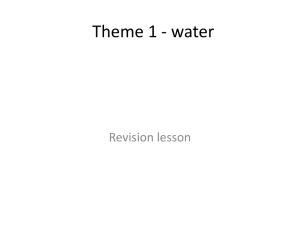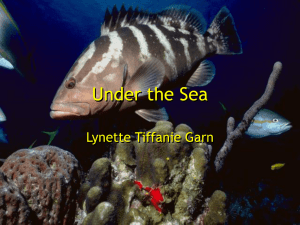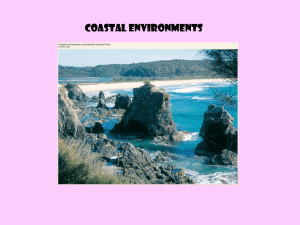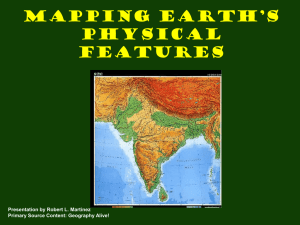Study Section A: Atmospheric Systems and People
advertisement
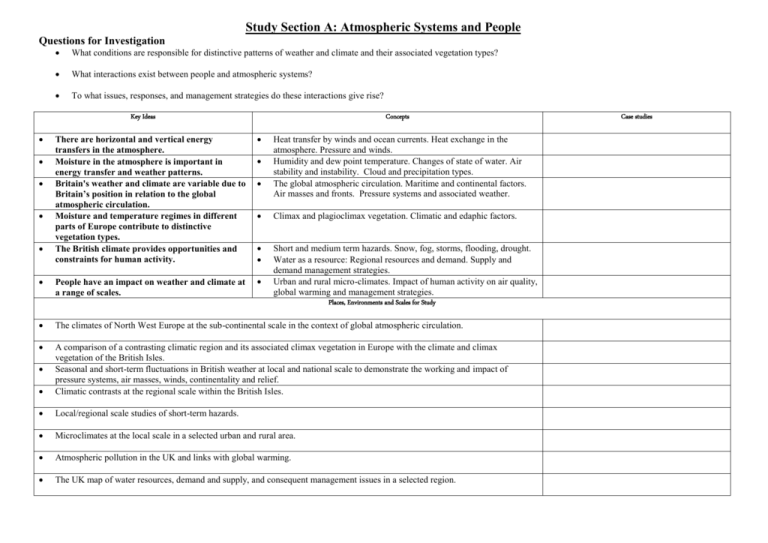
Study Section A: Atmospheric Systems and People Questions for Investigation What conditions are responsible for distinctive patterns of weather and climate and their associated vegetation types? What interactions exist between people and atmospheric systems? To what issues, responses, and management strategies do these interactions give rise? Key Ideas Concepts There are horizontal and vertical energy transfers in the atmosphere. Moisture in the atmosphere is important in energy transfer and weather patterns. Britain's weather and climate are variable due to Britain’s position in relation to the global atmospheric circulation. Moisture and temperature regimes in different parts of Europe contribute to distinctive vegetation types. The British climate provides opportunities and constraints for human activity. People have an impact on weather and climate at a range of scales. The climates of North West Europe at the sub-continental scale in the context of global atmospheric circulation. A comparison of a contrasting climatic region and its associated climax vegetation in Europe with the climate and climax vegetation of the British Isles. Seasonal and short-term fluctuations in British weather at local and national scale to demonstrate the working and impact of pressure systems, air masses, winds, continentality and relief. Climatic contrasts at the regional scale within the British Isles. Local/regional scale studies of short-term hazards. Microclimates at the local scale in a selected urban and rural area. Atmospheric pollution in the UK and links with global warming. The UK map of water resources, demand and supply, and consequent management issues in a selected region. Heat transfer by winds and ocean currents. Heat exchange in the atmosphere. Pressure and winds. Humidity and dew point temperature. Changes of state of water. Air stability and instability. Cloud and precipitation types. The global atmospheric circulation. Maritime and continental factors. Air masses and fronts. Pressure systems and associated weather. Climax and plagioclimax vegetation. Climatic and edaphic factors. Short and medium term hazards. Snow, fog, storms, flooding, drought. Water as a resource: Regional resources and demand. Supply and demand management strategies. Urban and rural micro-climates. Impact of human activity on air quality, global warming and management strategies. Places, Environments and Scales for Study Case studies Study Section B: Landform Systems and People Questions for Investigation What physical processes are operating on the landforms of fluvial environments? How are people interacting with these physical processes and systems? What issues, responses and management strategies arise from this? Key Ideas Concepts Fluvial processes combine with weathering and slope processes to produce distinctive landforms. Fluvial landform systems as the interaction between other systems: weathering, slope system, drainage basin system. Fluvial processes reflect the way in which the drainage basin sub-system of the hydrological cycle operates. The drainage basin system including changes resulting from variations in the hydrological cycle: river regimes, flow duration curves, storm hydrographs. Fluvial processes: channel efficiency, energy variations, geomorphological processes: erosion, transport and deposition. Valley landforms as a product of weathering, slope and fluvial processes: mass movement, basal removal and accumulation. Valley profiles, erosional, depositional and channel forms. Drainage basin systems can be modified by human activity. Vegetation change: cultivation, afforestation, urbanisation. Drainage basin systems and their landforms present management challenges. Unstable slopes and their control, upper catchment management, flood plains and their management including environmentally sensitive approaches. Places, Environments and Scales for Study Study of a major British drainage basin and a selected major basin outside Europe to illustrate principles of basin hydrology at the regional scale including the effects of human activity. Contrasting hydrographs for four British rivers. Landforms at the regional scale of a major river basin in the British Isles. Two comparative case studies to illustrate different approaches to catchment management and flood control at the local and regional scales. Case studies Study Section C: Coastal Systems and People Questions for Investigation What are the conditions and processes responsible for distinctive coastal landforms and ecosystems? How do people interact with these processes and systems? What issues and management strategies arise from this? Key Ideas Concepts Coastal processes and landforms reflect local winds and weather, coastal configuration and water movements. Erosion, transport and deposition by the sea. Cliff and beach systems. Sediment sources, movements and cells, and the associated erosional and depositional landforms. Distinctive ecosystems develop in coastal environments. Dune and coastal wetland ecosystems. Coastal processes and landforms can be modified by human activity. Coastal sand and gravel extraction, dune erosion, port construction Coastal systems and landforms present management challenges for people. Management of coastal erosion, dune systems and future sea level change. Sediment cells and integrated coastal management. Places, Environments and Scales for Study Coastal processes and landforms in a sediment cell, at the regional scale within North West Europe, which shows both erosional and depositional landforms. Coastal management strategies along a stretch of coastline, at the local and regional scale, where their effectiveness can be evaluated. Studies at the local scale of a dune system and a coastal wetland to illustrate contrasts in ecosystems, human impact and management strategies. Case studies

